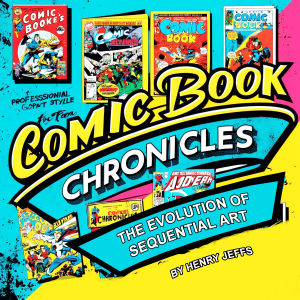

Comic Book Chronicles
Henry Jeffs
This audiobook is narrated by a digital voice.
The story of comic books begins long before the colorful pages we recognize today ever rolled off printing presses. Sequential art, the fundamental language of comics, traces its roots back to ancient civilizations where storytellers used series of images to convey narratives. Cave paintings in Lascaux, France, and hieroglyphics in Egyptian tombs demonstrate humanity's inherent desire to tell stories through connected visual sequences. These early forms established the basic principle that would later define comics: the power of images arranged in deliberate order to create meaning beyond what any single frame could achieve alone.
The transition from ancient pictorial storytelling to modern comics occurred gradually through various intermediary forms. Medieval tapestries like the Bayeux Tapestry documented historical events through sequential panels, while illuminated manuscripts combined text and imagery in ways that prefigured comic book layouts. During the Renaissance, broadsheets and chapbooks began experimenting with visual narrative techniques that would eventually evolve into comic strips and graphic novels.
The industrial revolution catalyzed the transformation of sequential art into mass media. Advances in printing technology made it economically feasible to produce illustrated publications for broad audiences. Wilhelm Busch's "Max and Moritz" in 1865 Germany demonstrated how sequential images could carry sophisticated humor and social commentary, influencing creators across Europe and America. This work established many conventions still used in comics today, including the use of panels to control pacing and the integration of dialogue within the visual narrative.
Duration - 35m.
Author - Henry Jeffs.
Narrator - Digital Voice Matt G.
Published Date - Saturday, 18 January 2025.
Copyright - © 2025 Henry Jeffs ©.
Location:
United States
Description:
This audiobook is narrated by a digital voice. The story of comic books begins long before the colorful pages we recognize today ever rolled off printing presses. Sequential art, the fundamental language of comics, traces its roots back to ancient civilizations where storytellers used series of images to convey narratives. Cave paintings in Lascaux, France, and hieroglyphics in Egyptian tombs demonstrate humanity's inherent desire to tell stories through connected visual sequences. These early forms established the basic principle that would later define comics: the power of images arranged in deliberate order to create meaning beyond what any single frame could achieve alone. The transition from ancient pictorial storytelling to modern comics occurred gradually through various intermediary forms. Medieval tapestries like the Bayeux Tapestry documented historical events through sequential panels, while illuminated manuscripts combined text and imagery in ways that prefigured comic book layouts. During the Renaissance, broadsheets and chapbooks began experimenting with visual narrative techniques that would eventually evolve into comic strips and graphic novels. The industrial revolution catalyzed the transformation of sequential art into mass media. Advances in printing technology made it economically feasible to produce illustrated publications for broad audiences. Wilhelm Busch's "Max and Moritz" in 1865 Germany demonstrated how sequential images could carry sophisticated humor and social commentary, influencing creators across Europe and America. This work established many conventions still used in comics today, including the use of panels to control pacing and the integration of dialogue within the visual narrative. Duration - 35m. Author - Henry Jeffs. Narrator - Digital Voice Matt G. Published Date - Saturday, 18 January 2025. Copyright - © 2025 Henry Jeffs ©.
Language:
English
Start
Duration:00:35:17